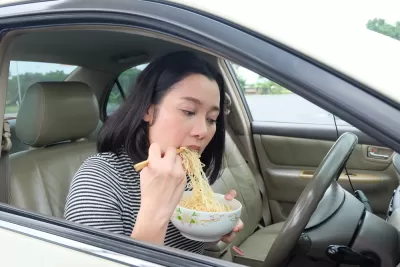A columnist explores how to create an environment that encourages focused, safe driving.

Want to reduce distracted driving? Think outside the textalyzer, researchers say.
Scott Sturgis, auto columnist for The Philadelphia Inquirer, spoke to traffic safety experts about what takes drivers' focus off the road—and found that it goes far beyond phone use. Car design and the built environment can create—or help prevent—disruptions to attention.
Of course, individuals aren't off the hook for how they drive; "personal responsibility" is on Sturgis's list of solutions. To address it, national agencies are working on campaigns to influence social norms and taboos.
But environmental factors also play a role, according to Sturgis's research. Here are other things to consider in attempts to reduce distracted driving.
- Engaging roadway design: A clear example is the use of roundabouts, which require drivers to stay alert for other cars without being stopped at a traffic signal.
- Intuitive vehicle design: Cars themselves can create distractions for the drivers in them. This applies to safety controls, like automatic braking and lane-departure warnings, as much as it does to stereo and A/C systems.
- App design: "There's real potential to effect change…on the mobile side," Sturgis writes. Some smartphone apps are seeking to gamify good driving—turning phoneless driving into a competition. Others are studying ways to provide real-time feedback on risky road behavior.
FULL STORY: Drivers are distracted by more than cellphones. Here's what can help them focus

Planetizen Federal Action Tracker
A weekly monitor of how Trump’s orders and actions are impacting planners and planning in America.

Congressman Proposes Bill to Rename DC Metro “Trump Train”
The Make Autorail Great Again Act would withhold federal funding to the system until the Washington Metropolitan Area Transit Authority (WMATA), rebrands as the Washington Metropolitan Authority for Greater Access (WMAGA).

The Simple Legislative Tool Transforming Vacant Downtowns
In California, Michigan and Georgia, an easy win is bringing dollars — and delight — back to city centers.

The States Losing Rural Delivery Rooms at an Alarming Pace
In some states, as few as 9% of rural hospitals still deliver babies. As a result, rising pre-term births, no adequate pre-term care and "harrowing" close calls are a growing reality.

The Small South Asian Republic Going all in on EVs
Thanks to one simple policy change less than five years ago, 65% of new cars in this Himalayan country are now electric.

DC Backpedals on Bike Lane Protection, Swaps Barriers for Paint
Citing aesthetic concerns, the city is removing the concrete barriers and flexposts that once separated Arizona Avenue cyclists from motor vehicles.
Urban Design for Planners 1: Software Tools
This six-course series explores essential urban design concepts using open source software and equips planners with the tools they need to participate fully in the urban design process.
Planning for Universal Design
Learn the tools for implementing Universal Design in planning regulations.
Smith Gee Studio
City of Charlotte
City of Camden Redevelopment Agency
City of Astoria
Transportation Research & Education Center (TREC) at Portland State University
US High Speed Rail Association
City of Camden Redevelopment Agency
Municipality of Princeton (NJ)


























